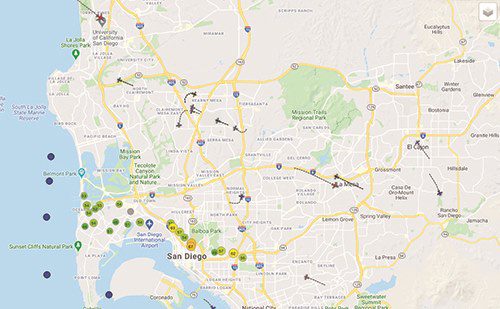Plenty of unknown challenges emerged when COVID-19 turned the industry upside down in a matter of weeks. San Diego International Airport (SAN) also found an opportunity. While air traffic is at record lows due to the global pandemic, the metropolitan airport is analyzing how the noise data it routinely collects correlates with the number of noise complaints from the community.
Spoiler alert: The relationship is not what you might expect.
Plenty of unknown challenges emerged when COVID-19 turned the industry upside down in a matter of weeks. San Diego International Airport (SAN) also found an opportunity.
 While air traffic is at record lows due to the global pandemic, the metropolitan airport is analyzing how the noise data it routinely collects correlates with the number of noise complaints from the community. Spoiler alert: The relationship is not what you might expect.
While air traffic is at record lows due to the global pandemic, the metropolitan airport is analyzing how the noise data it routinely collects correlates with the number of noise complaints from the community. Spoiler alert: The relationship is not what you might expect.
An uptick in complaints while flight operations are down dramatically has airport officials somewhat perplexed. What the research will ultimately lead to is not yet clear, but Sjohnna Knack, SAN’s program manager for Airport Planning and Environmental Affairs, says that it is important to assemble the data now and determine how to use it later.
“The study is really just to capture this moment and what this [operating level] actually sounds like,” she explains. “It’s a way to let people know where we’re at.”
|
Project: Study of Noise Complaints Location: San Diego Int’l Airport Impetus: Dramatically reduced air traffic during COVID-19 pandemic Cost: No additional expenses were incurred because airport routinely collects & analyzes noise data; new noise consultant worked gratis Airport Noise & Operations Monitoring System; Noise Data Analysis: Envirosuite Noise Consultant: HMMH Key Finding: Although airport-generated noise dropped as operations dramatically decreased, noise complaints from the community spiked before settling back to pre-COVID levels. Follow-up Action: Airport Noise Advisory Committee will use COVID-related data to analyze whether additional noise abatement steps are needed. |
Knack also sees a silver lining in the coronavirus fallout: “We have this unique opportunity to re-engage with our communities.”
Unexpected Response
Like many airports, SAN continually monitors audio levels in the communities around its facility to help evaluate its noise abatement strategies and programs. Collected data also helps guide the development of aircraft departure/arrival procedures that minimize the impact of aircraft noise based on altitude, flight path and time of day. SAN’s Airport Noise and Operations Monitoring System by Envirosuite uses 23 strategically placed microphones on steel poles to collect information about airport and other ambient noise from nearby communities. Data is collected and sent via wireless connection for continuous analysis.
For years, SAN has contracted Envirosuite, a global company that specializes in environmental intelligence technology, to help collect and decipher the data. For its special COVID-19 analysis, the airport connected Envirosuite with the aviation division of HMMH, a noise consultant based in nearby Anaheim, CA. The firm has also studied noise issues at a general aviation airport near SAN, and multiple national and international airports have expressed interest in providing their data for analysis.
When a community member files a noise complaint with SAN, Knack’s team uses Envirosuite’s tools to match it up with the corresponding noise and aircraft information. “We’re looking at the flight tracks—where our aircraft are going in relation to the ground, how high they’re flying and other factors,” Knack explains. “We do this to see if we can make adjustments and to help educate the community.”
Less Noise, but More Complaints?
 Oddly, as landings and departures began to decrease in mid-March (when health officials encouraged travelers to stay at home), SAN experienced a notable uptick in community noise complaints. Pre-pandemic, the single-runway airport averaged nearly 600 daily operations; by late April, daily operations had dwindled to 134. During roughly the same period, the airport’s community noise equivalent level (CNEL), a 24-hour noise measurement metric, dropped from around 66 decibels in January to a low of about 54 decibels in June—a decline that would have been perceived as at least 50% less noise. In fact, beginning in April and running through June, the airport’s noise level was lower than the noise level of the rest of the community—something that rarely occurs, notes Justin Cook, a principal consultant with HMMH.
Oddly, as landings and departures began to decrease in mid-March (when health officials encouraged travelers to stay at home), SAN experienced a notable uptick in community noise complaints. Pre-pandemic, the single-runway airport averaged nearly 600 daily operations; by late April, daily operations had dwindled to 134. During roughly the same period, the airport’s community noise equivalent level (CNEL), a 24-hour noise measurement metric, dropped from around 66 decibels in January to a low of about 54 decibels in June—a decline that would have been perceived as at least 50% less noise. In fact, beginning in April and running through June, the airport’s noise level was lower than the noise level of the rest of the community—something that rarely occurs, notes Justin Cook, a principal consultant with HMMH.
In spite of this, noise complaints from the community jumped in late March, hitting a single-day high of 778, after hovering between 300 and 500 daily complaints in January and February. Complaints dropped to around 200 per day in April and stayed there through June.
Knack and others note that the March spike in noise complaints could be attributed to more residents being home all day due to the pandemic—residents who were unaccustomed to, and more sensitive to, aircraft noise.
Matt Mills-Brookes, a senior aviation specialist for Envirosuite, reports that data captured by his company indicates that airport noise dropped throughout the world by 50% or more after the pandemic hit. Community noise dropped as well, as there were far fewer commuters and business vehicles on the roads.
“For noise, halving is a massive change,” Mills-Brookes emphasizes. “We would have thought that as communities got quieter and there were less aircraft, the complaints would almost drop to zero; but they didn’t. They remained quite high. The ratio of complaints to the number of flights actually went up [after the emergence of] COVID.”

The Psychology of Noise Complaints
The seeming mismatch of measured noise levels and associated complaints naturally led to a discussion about what actually drives noise complaints from the community. Airport managers understand that beyond the noise of aircraft operations, non-acoustic factors play a key role in how neighbors perceive airport noise. Such factors include the community’s level of trust in airport authorities to control noise levels and individuals’ attitudes regarding aircraft noise and whether it is going to get better or worse next year.
Mills-Brookes adds that the pandemic may have broadened non-acoustic factors—for instance, residents may now be concerned about the potential increase in virus transmission from inbound passengers. And such attitudes, whether conscious or subconscious, could lead to increased noise complaints. Conversely, as traffic at SAN increases, some community members may interpret more flight activity as a positive sign of economic recovery.

Interestingly, Mills-Brookes says that non-acoustic factors have a significantly greater influence on a community’s annoyance than the actual aircraft noise. That, he reasons, is why the community’s feelings about air travel in and out of San Diego during the current pandemic are so important and impactful. This heightens the need for SAN officials to focus on community outreach programs that reinforce the airport’s efforts to be a conscientious member of the community during and after the pandemic.
Mills-Brookes emphasizes that this is an important time for all airport executives to be positive industry ambassadors in their individual communities. “We need to be the face of the industry—to be proactive and tell the community, ‘It’s a safe operation. The airlines are using COVID safety procedures and bringing jobs back.’ It’s important to let people know that you’re working with the airlines to keep noise levels as low as possible.”
Knack reports that the team at SAN is up for the task, and is leveraging its long-standing Airport Noise Advisory Committee, which includes community members as well as aviation stakeholders such as airlines and local elected officials. The committee is overseeing a noise compatibility study to help generate recommendations for viable noise abatement measures.
“Hopefully, before we get ramped up to our historic passenger levels—whether that is three or more years from now—we can re-engage with the community in a positive and productive manner to work cooperatively,” she says. “It’s all part of working together to see if anything can be done better.”


 facts&figures
facts&figures

